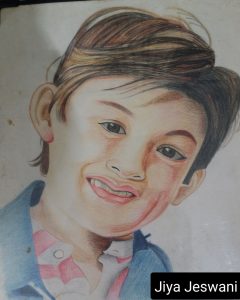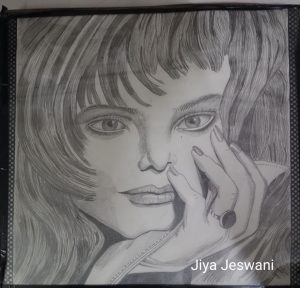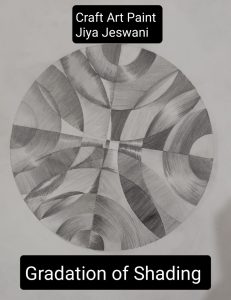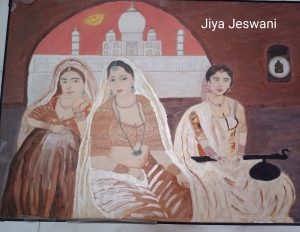Craft Art Painting Oil Drawing Pencil Sketching Artwork Classes
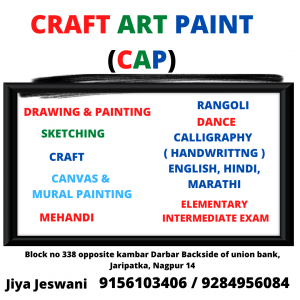
Craft Art Painting Oil Drawing Pencil Sketching Artwork Classes
CRAFT ART PAINT ( CAP )
1. DRAWING & PAINTING
2. SKETCHING
3. CRAFT
4. CANVAS & MURAL PAINTING
5. MEHANDI
6. RANGOLI
7. DANCE
8. CALLIGRAPHY ( HANDWRITTNG ) ENGLISH, HINDI, MARATHI
9. ELEMENTARY INTERMEDIATE EXAM
CONTACT
JIYA JESWANI 9284956084 / 9156103406
#drawing #drawingsketch #painting #portrait #sketching #craft #canvaspainting #calligraphy #elementary #intermediate #oilpainting #pencildrawing #dance #calligraphy #mehndi #drawingtutorial #paintingclass #drawingclass #oilpaintingoncanvas #oilpaintingart #rangoli
Craft Art Painting Oil Drawing Pencil Sketching Artwork Classes
Craft Art Painting Oil Drawing Pencil Sketching Artwork Classes
- Introduction to Craft Art Painting (CAP)
Craft Art Painting, or CAP, is an umbrella term that encompasses a wide range of art forms, including drawing and painting, sketching, craft, canvas and mural painting, Mehandi, Rangoli, dance, and calligraphy. Each of these art forms has its own unique techniques and styles, and each one offers its own set of benefits and challenges. Whether you’re a beginner or an experienced artist, there is something for everyone within the world of CAP.
- Drawing and Painting
Drawing and painting are two of the most fundamental art forms within the world of CAP. Whether you’re working with oil paints, watercolors, or pencils, the goal of drawing and painting is to create a visual representation of the world around you. This can take many different forms, from still life drawings to portraits to landscapes.
In order to improve your skills in drawing and painting, it’s important to practice regularly and to experiment with different techniques and styles. You can also take classes or workshops to learn from experienced artists and to receive feedback on your work.
III. Sketching
Sketching is a form of drawing that is typically done quickly and with a focus on capturing the essence of a scene or subject. Sketches can be created with a variety of tools, including pencils, pens, or charcoal.
Sketching is a great way to capture your thoughts and ideas in a quick and intuitive manner. It can also help you to improve your observation skills and to become more comfortable with your tools and materials.
- Craft
Craft is a term that encompasses a wide range of creative activities, including knitting, crocheting, woodworking, and more. Within the world of CAP, craft often involves the creation of decorative or functional objects using a variety of materials and techniques.
Craft can be a relaxing and meditative activity, and it’s a great way to express your creativity while also making something useful or beautiful. Whether you’re creating a piece of jewelry, a piece of furniture, or a decorative item, the possibilities are endless with craft.
- Canvas and Mural Painting
Canvas and mural painting involves the creation of large-scale paintings on canvas or directly on walls. This type of painting can be used to create a dramatic statement in any room, and it can be a great way to make an impact in public spaces.
Canvas and mural painting requires a great deal of skill and experience, as well as the ability to work on a large scale. Whether you’re creating a portrait or a landscape, the goal is to create a visually stunning piece of art that captures the viewer’s attention.
- Mehandi
Mehandi is the art of creating intricate designs on the skin using henna. This type of body art is commonly used in celebrations and special events, and it’s a great way to add a touch of beauty and creativity to any occasion.
Mehandi involves a great deal of skill and precision, as well as an understanding of the various designs and patterns that are used in this art form. Whether you’re creating simple designs or complex patterns, Mehandi offers a unique and beautiful way to express your creativity.
VII. Rangoli
Rangoli is an Indian art form that involves creating intricate designs on the floor using colored sand or powder. This type of art is often used in religious and cultural celebrations, and it’s a great way to bring color and beauty to any space.
Rangoli requires a great deal of skill and precision, as well as an understanding of the various designs and patterns that are used in this art form. Whether you’re creating simple designs or more elaborate patterns, Rangoli offers a unique and beautiful way to express your creativity and to add a touch of color and beauty to your home or event.
VIII. Dance
Dance is a form of physical expression that involves moving your body to music or other forms of rhythm. Within the world of CAP, dance can take many different forms, from classical ballet to contemporary dance to hip hop.
Dance is a great way to improve your physical fitness and to express yourself creatively. Whether you’re a beginner or an experienced dancer, there is a dance style that will suit your interests and abilities.
- Calligraphy (Handwriting)
Calligraphy is the art of creating beautiful, stylized writing using pens, brushes, or other tools. Within the world of CAP, calligraphy can take many different forms, including English, Hindi, and Marathi.
Calligraphy requires a great deal of skill and practice, as well as an understanding of the various styles and techniques used in this art form. Whether you’re creating handwritten letters, cards, or posters, calligraphy offers a unique and beautiful way to express your creativity and to add a touch of elegance to your writing.
- Elementary, Intermediate, and Exam
Craft Art Painting Oil Drawing Pencil Sketching Artwork Classes
- Drawing & Painting:
- Fundamentals of drawing and painting
- Understanding color theory and composition
- Techniques for using different types of paints, including watercolors, acrylics, and oils
- Creating paintings from still life, landscape, and portrait subjects
- Exploring different painting styles and techniques
- Learning to critique and analyze artwork
- Sketching:
- Fundamentals of sketching, including perspective, shading, and observation
- Sketching from life and reference images
- Exploring different sketching styles, including realistic, stylized, and abstract
- Learning to critique and analyze sketches
- Craft:
- Introduction to various traditional and contemporary crafts
- Working with different materials such as paper, fabric, and clay
- Techniques for creating 3D objects, jewelry, and home decor items
- Learning to critique and analyze craftwork
- Canvas & Mural Painting:
- Techniques for painting on different surfaces, including canvas, walls, and other large surfaces
- Creating murals and large-scale paintings
- Exploring different painting styles and techniques for large surfaces
- Learning to critique and analyze large-scale paintings
- Mehandi:
- Introduction to the history and cultural significance of henna
- Techniques for applying henna and creating intricate designs
- Creating designs for special occasions such as weddings and festivals
- Learning to critique and analyze mehandi designs
- Rangoli:
- Introduction to the history and cultural significance of rangoli
- Techniques for creating traditional Indian floor art using colorful powders
- Creating designs for special occasions such as weddings and festivals
- Learning to critique and analyze rangoli designs
- Dance:
- Introduction to different styles of dance, including Bollywood, classical Indian dance, and contemporary dance
- Learning basic dance techniques and choreography
- Exploring different dance styles and techniques
- Learning to critique and analyze dance performances
- Calligraphy:
- Introduction to different writing styles, including English, Hindi, and Marathi
- Techniques for creating beautiful lettering and designs
- Learning basic design principles for creating visually appealing calligraphy
- Learning to critique and analyze calligraphy work
- Elementary Intermediate Exam:
- Testing students’ knowledge and skills in the various topics covered in the course
- Providing feedback and suggestions for improvement
- Helping students track their progress and set goals for further study.
Craft Art Painting Oil Drawing Pencil Sketching Artwork Classes
- Drawing & Painting:
- Creating different textures and effects with paints, such as blending, layering, and scumbling
- Understanding color mixing and color matching
- Creating artwork with a range of values and contrasts
- Developing a personal style and artistic voice
- Working with different painting tools, such as brushes, knives, and sponges
- Exploring different painting surfaces, such as paper, canvas, and wood
- Understanding the history and evolution of painting and its impact on art and culture
- Sketching:
- Creating sketches with different media, such as pencils, charcoal, and pastels
- Developing an understanding of proportion, foreshortening, and scale
- Creating sketches with a range of values and contrasts
- Exploring different sketching techniques, such as hatching, cross-hatching, and stippling
- Understanding the history and evolution of sketching and its impact on art and culture
- Craft:
- Understanding the cultural and historical context of different crafts
- Creating crafts with a range of materials, such as paper, fabric, and clay
- Developing an understanding of design and aesthetics in craftwork
- Exploring different crafting techniques, such as cutting, sewing, and molding
- Understanding the evolution of different crafts and their impact on art and culture
- Canvas & Mural Painting:
- Understanding the techniques of different painting styles, such as impressionism, expressionism, and abstract art
- Creating artwork with a range of moods and emotions
- Developing an understanding of color symbolism and its use in painting
- Understanding the historical and cultural context of different painting styles
- Creating murals and large-scale paintings with different techniques, such as spray painting, stenciling, and mural transfer
- Mehandi:
- Understanding the different designs and patterns used in mehandi
- Developing an understanding of cultural and social significance of mehandi
- Creating complex and intricate mehandi designs
- Exploring different techniques and styles of mehandi, such as Arabic mehandi, Indo-Arabic mehandi, and Rajasthani mehandi
- Rangoli:
- Understanding the different geometric and symbolic elements used in rangoli designs
- Developing an understanding of the cultural and social significance of rangoli
- Creating complex and intricate rangoli designs
- Exploring different techniques and styles of rangoli, such as freehand rangoli, stencil rangoli, and computer-generated rangoli
- Dance:
- Developing an understanding of rhythm, tempo, and music in dance
- Learning more advanced dance techniques and choreography
- Understanding the cultural and social context of different dance styles
- Creating and performing a dance routine
- Critiquing and analyzing dance performances and choreography
- Calligraphy:
- Developing an understanding of the historical and cultural significance of calligraphy
- Creating more complex and intricate lettering and designs
- Exploring different writing styles and scripts, such as Italic, Gothic, and Copperplate
- Understanding the use of calligraphy in different cultural and social contexts, such as wedding invitations and certificates
- Elementary Intermediate Exam:
- Testing students on more advanced knowledge and skills in the various topics covered in the course
- Providing feedback and suggestions for improvement
- Helping students develop their artistic and creative abilities
- Preparing students for further study and professional opportunities in art, craft, and design.
Regardless of which art form within the world of CAP you’re interested in, it’s important to have a solid foundation in the basics. This is why many CAP classes and workshops offer elementary and intermediate levels, as well as exams to help you gauge your progress and to track your development as an artist.
Whether you’re just starting out or you’re an experienced artist looking to improve your skills, the world of CAP offers a wealth of opportunities for creativity, expression, and growth. So why not explore the many different art forms within this field, and find the one that speaks to you the most?
When it comes to learning and mastering the different art forms within CAP, it’s important to find a teacher or mentor who can guide you through the process. Look for instructors who have experience in your chosen art form, and who have a track record of helping students to improve and excel.
In addition to taking classes and workshops, it’s also important to practice on your own and to seek out opportunities to showcase your work. This might involve creating your own portfolio, participating in local art fairs and exhibitions, or even selling your artwork online or through other channels.
Finally, don’t forget to have fun and enjoy the process of creating art. While it can be challenging and frustrating at times, the world of CAP is ultimately about expressing yourself and sharing your unique vision with the world. So don’t be afraid to take risks, to experiment with new techniques and styles, and to let your creativity run wild. Who knows – you just might discover a whole new world of art and beauty that you never even knew existed.
what could be covered in a CRAFT ART PAINT (CAP) course:
- Drawing and painting techniques, including color theory, composition, and various media such as watercolors, acrylics, and oils.
- Sketching fundamentals, including perspective, shading, and sketching from observation.
- Craft techniques, including paper crafts, fabric crafts, and other traditional crafts.
- Canvas and mural painting, including techniques for painting on large surfaces, creating murals, and working with different types of paints.
- Mehandi, including techniques for applying and creating intricate henna designs.
- Rangoli, including techniques for creating traditional Indian floor art using colorful powders.
- Dance, including basic techniques and choreography for a variety of styles such as Bollywood, classical Indian dance, and contemporary dance.
- Calligraphy, including instruction on writing in English, Hindi, and Marathi, as well as basic design principles for creating beautiful lettering.
- Elementary and intermediate exams to test students’ knowledge and skills in the various topics covered in the course.
CRAFT ART PAINT (CAP) is a course that focuses on developing artistic and creative abilities in various fields, such as drawing and painting, sketching, craftwork, canvas and mural painting, mehandi, rangoli, dance, calligraphy, and more.
The CRAFT ART PAINT (CAP) course can be taken by anyone who has an interest in art, craft, and design. It is suitable for beginners as well as those who have some experience in these fields.
The learning outcomes of the CRAFT ART PAINT (CAP) course include developing skills and knowledge in various artistic and creative fields, such as drawing, painting, sketching, craftwork, and dance. It also aims to help students develop their personal style and artistic voice, and prepare them for further study and professional opportunities in the arts.
The materials required for the CRAFT ART PAINT (CAP) course may vary depending on the specific topic being covered. For example, for drawing and painting, students may need paints, brushes, canvases, and other tools. For sketching, they may need pencils, charcoal, and paper. For craftwork, they may need fabrics, beads, and other materials.
The CRAFT ART PAINT (CAP) course is typically taught through offline and online a combination of lectures, demonstrations, practical exercises, and hands-on projects. It may also include field trips, guest speakers, and critiques of student work.
Yes, the CRAFT ART PAINT (CAP) course may include an elementary intermediate exam or other assessments to test students’ knowledge and skills in the various topics covered. These exams may include written tests, practical exercises, or other forms of assessment.
Those who complete the CRAFT ART PAINT (CAP) course may go on to pursue careers in various fields, such as fine arts, graphic design, illustration, fashion design, and more. They may also start their own businesses in art and craft, or work as freelancers, consultants, or educators in the field.
Some of the benefits of taking the CRAFT ART PAINT (CAP) course include developing creativity, improving manual dexterity and fine motor skills, building confidence, and learning how to express oneself through various artistic mediums.
No, it is not necessary to have prior experience in art to take the CRAFT ART PAINT (CAP) course. The course is designed for beginners as well as those with some experience in art, and the curriculum is tailored to meet the needs of each student.
Yes, the CRAFT ART PAINT (CAP) course can be taken online through various platforms that offer distance learning. However, some topics may require hands-on experience that is best learned in person.
The duration of the CRAFT ART PAINT (CAP) course may vary depending on the specific program or institution offering the course. It may range from a days to months.
Yes, the skills learned in the CRAFT ART PAINT (CAP) course can be applied to other fields such as graphic design, product design, and advertising. The course teaches foundational skills such as composition, color theory, and manual dexterity that are transferable to other fields.
The minimum age requirement to take the CRAFT ART PAINT (CAP) course may vary depending on the specific program or institution offering the course. However, some programs may require students to be at least 16 years old.
The cost of the CRAFT ART PAINT (CAP) course may vary depending on the specific program or institution offering the course. It may also depend on the duration of the course and the materials required. It is advisable to research and compare the costs of different programs before enrolling.

